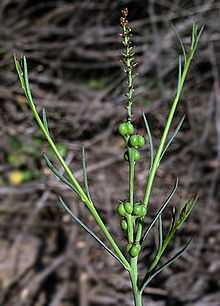Stillingia linearifolia
| Stillingia linearifolia | |
|---|---|
 | |
| Scientific classification | |
| Kingdom: | Plantae |
| (unranked): | Angiosperms |
| (unranked): | Eudicots |
| (unranked): | Rosids |
| Order: | Malpighiales |
| Family: | Euphorbiaceae |
| Subfamily: | Euphorbioideae |
| Tribe: | Hippomaneae |
| Subtribe: | Hippomaninae |
| Genus: | Stillingia |
| Species: | S. linearifolia |
| Binomial name | |
| Stillingia linearifolia S.Watson | |
Stillingia linearifolia is a species of flowering plant in the euphorb family known by the common name queens-root. It is native to the southwestern United States and northern Mexico, where it occurs in several types of dry and disturbed habitat in deserts, mountains, and foothills. It is a perennial herb producing a clump of slender, branching, erect stems approaching 70 centimeters in height. The alternately arranged leaves are linear and narrow, reaching 4 centimeters in length but less than 2 millimeters in width. The inflorescence is an erect spike of flowers a few centimeters long. The plant is monoecious, and each spike has several male flowers at the tip and a few fruit-bearing female flowers below these. Neither type of flower has petals. The ovary of the female flower develops into a three-lobed greenish capsule 3 to 4 millimeters wide. There is a tiny black seed in each of the three chambers of the fruit.